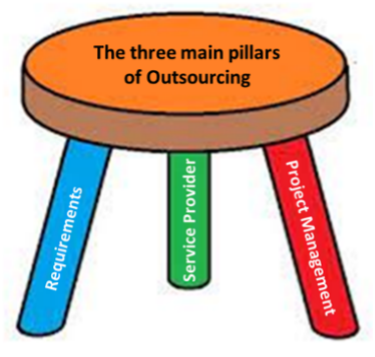What is outsourcing?

Outsourcing is the practice of hiring another company (generally referred to as a service provider) to perform a task or service that is typically done in-house. It can include a variety of functions such as software development and IT, manufacturing, customer service, accounting, and many others. Outsourcing can be done domestically or internationally, depending on your needs and your strategy. In this blog, we will discuss the main elements of outsourcing and how to put the two and two together.
What are the benefits of outsourcing?
The primary advantages of outsourcing, especially for software development and IT tasks, are as follows:
- Cost Savings. By outsourcing certain tasks, you can take advantage of lower labor costs in other countries. For example, software and IT labor cost in India is generally less than half the cost in the United States while talent quality is as good. Additionally, you can save money on overhead expenses such as benefits and office space, as well as avoiding the costs associated with recruiting and training new employees.
- Access to Global Talent. Outsourcing can provide you with access to a global talent pool. With advancements in technology, it's easier than ever to find and work with service providers in other countries. This can give you access to a wider range of skills and expertise, and can also help you expand your business into new markets.
- Focus on core business functions. Outsourcing can help your business become more efficient. By delegating certain tasks to a third-party service provider, you can free up your in-house talents to focus on more critical and sensitive business functions.
- Access to specialized expertise. Outsourcing can help you access specialized expertise that may not be available in-house. For example, you may be able to outsource your AI-based software development to a service company that specializes in this area, allowing you to benefit from their experience and knowledge.
- Scalability. Outsourcing can enable you to scale your team up or down quickly in response to changing market conditions or business needs.
Are there any downsides to outsourcing?
Despite its benefits, outsourcing can present challenges that need to be managed.
- Quality Control. The quality of work provided by a service provider may not always meet your company's standards. This can lead to issues with product quality and customer satisfaction. To prevent such issues, you need to document your requirements and quality expectations in detail, and you also need to closely manage the delivery of the requirements by conducting rigorous acceptance testing on a regular basis.
- Working in different time zones. Managing an outsourced team can prove to be challenging, particularly when they are in a different time zone. By documenting your requirements, establishing a detailed project plan, regular check-ins and communication, and closely monitoring progress, you can overcome the challenges. In fact, in our experience, in some cases you can actually turn the time difference to your advantage and increase your productivity. For example, if your outsourced development team is based in India, you can do functional, usability or acceptance testing during the day time in the U.S. while it’s night time in India, record any issues in a shared document for the team in India to address during their day time while it is night time in the U.S. This approach, known as the "Follow the Sun" strategy, allows for continuous progress without delays, as both teams can work around the clock.
- Communication challenges. Communication challenges can arise when working with a service provider that speaks a different language, has a different culture, or is located in a different time zone. This can result in miscommunication, delays, and other issues. In our experience, the best way to mitigate this challenge is more written communication, regular communication, over-communication, and providing as much details as possible.
- Confidentiality concerns. Outsourcing can expose businesses to increased risks of data breaches and other security issues, especially when sensitive data is being shared with a service provider. In cases where the project involves confidential information, it's best to rely on your core team whenever possible. However, if outsourcing is the only option, it's essential to have a signed non-disclosure agreement (NDA) with the service provider to protect your intellectual property. Moreover, if your outsourcing team is critical to the project's success, consider offering them equity in the venture to incentivize their commitment and accountability.
- Dependency on a third party. Outsourcing can create a dependency on a service provider, making it challenging to bring work back in-house if needed. This can limit the organization's flexibility and ability to adapt to changing business needs. There are two alternatives to consider. The first alternative is to build a strong, long-term relationship with the outsourcing partner for product development and maintenance. This can be formalized through a Service Level Agreement (SLA) to ensure both parties are aligned on expectations and responsibilities. The second alternative is to invest in staff training to develop in-house expertise and reduce reliance on the outsourcing partner.
When should you consider outsourcing?
Effective leaders and managers carefully evaluate their options before finalizing a plan. If you answer YES to any of the following questions, outsourcing should be considered as an option.
- Are you a startup or SMB working with limited funding?
- Do you need to reduce your development costs?
- Do you need to quickly get access to specialized talents for your project?
- Do you need to scale up your team rapidly to meet your business goals?
- Have you been trying to hire expertise, but without any success?
- Are you planning to establish a global presence for your business?
Tips for Successful Outsourcing

Executing an outsourcing strategy can be challenging if your organization lacks any experience in outsourcing. To assist you, we have provided a brief description of the main pillars of successful outsourcing below.
- Detailed requirements. A well-documented set of detailed requirements is the cornerstone of successful outsourcing, as it enables the evaluation of service company candidates and facilitates more accurate time and cost estimates for project development. It also allows service providers to reliably plan and implement the project.
Having a comprehensive and well-documented list of requirements eliminates guesswork and prevents confusion regarding expectations.
- Choosing the right service provider. When outsourcing, it's important to choose the right service provider. Look for a service company that has experience in your industry and that has a proven track record of success. Additionally, look for a service provider that has the resources and expertise with the right leadership to meet your specific requirements.
- Hand-on project management. It is critical to regularly monitor the performance of your outsourcing service provider. This can help you identify any issues early on and ensure that the work will be completed to your satisfaction. In our experience, the following methods can be instrumental in managing the execution phase.
a) Detailed project plan. You need to break the project into a series of major milestones with target completion dates, backed by detailed deliverables and target completion dates for achieving the milestones.
b) Coordination and check-ins. You need to schedule a regular weekly team meeting (in some situations, bi-weekly) with your service provider team over live video. The weekly team meetings can be used for tracking progress against milestones and deliverables, discuss issues and develop a resolution plan.
c) Communication. Another major element of your project management should center around regular and clear communication with your service provider, both written and verbal. Nothing can be and should be informal or assumed. It is also important to agree on a set of tools that will be used for communication including live video, phone calls, email, and messaging, and a set of shared documents to capture tasks, issues and status.
d) Finally, we highly recommend to be open to feedback from your service provider and be willing to make adjustments as needed.
Conclusion
Outsourcing can be a cost-effective way to grow your business, improve efficiency, and access specialized expertise. By approaching outsourcing strategically and following best practices, you can ensure that you're getting the most out of your outsourcing partnerships. With the right approach, outsourcing can be a powerful tool for achieving your business goals and staying ahead of the competition.

